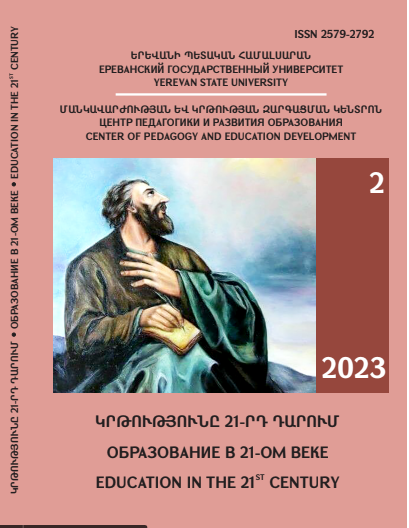SOCIOCULTURAL COMMENTARY IN TEACHING LITERATURE (ON THE MATERIAL OF "BELKIN'S NOVELS" BY A.S. PUSHKIN)
DOI:
https://doi.org/10.46991/ai.2023.2.188Keywords:
socio-cultural commentary, , Russian language,, Russian literature,, fiction textAbstract
The article is devoted to the concept of socio-cultural commentary and the problem of its importance and necessity when analyzing a fiction text and teaching literature. In particular, we address the theme of social inequality of characters, which is more fully revealed if we take into account the socio-cultural commentary with which we have accompanied some parts of the text. The purpose of our work is to show the importance of socio-cultural commentary for any text in teaching foreign literature and to provide as complete a commentary as possible of "Tales of Belkin" by A.S. Pushkin.
The relevance of such work consists not only in addressing the problem of the importance of supplying socio-cultural commentary for a fiction text, which has been little studied in the literature, but also in the need for a more complete explanation of the texts of Alexander Pushkin's “Tales of Belkin”. The choice of this particular cycle of the writer for such an analysis is conditioned by the fact that works from it are most often chosen as teaching material in the process of studying Russian language by Armenian students and schoolchildren. As a rule, they are also chosen for familiarization with Pushkin's prose works both in Armenian schools and in the process of studying them by foreign students abroad.
The scientific novelty of the work lies in the fact that the texts of the tales are equipped with socio-cultural comments, because the existing comments of an encyclopedic character are insufficient for an adequate understanding of the texts.
We have analyzed those parts of the text of "Tales of Belkin" that were clear to Pushkin's contemporaries, but have lost their significance for today's reader.
Conclusions: The most insignificant details for the modern reader can tell a lot about the characters', belonging to one or another social group, for example, the number of horses, harnessed to the characters' means of transportation, indicates their social status. We have demonstrated how important this detail is for the adequate perception of the text. Another indicator of the material condition of the characters are household items, clothes of the characters.
Important in the texts of the tales is the motif of "rubles and nickels", connected with the theme of money in the texts. The research was aimed at clarifying more clearly the material situation that was characteristic of this or that character.
Having analyzed the most "silent" for today's reader places in the tales, we came to the conclusion how important it is to have socio-cultural commentary on the work of fiction when teaching literature.
References
Список использованной литературы
Баршт К.А. О направлениях и пределах комментирования художественного текста // Вопросы литературы 2009, N5. – С. 280-303.
Беловинский Л.В. Иллюстрированный энциклопедический историко- бытовой словарь русского народа XVIII – начало XX в. – М.: ЭКСМО, 2007. – 784с.
Белькинд В. С. Образ “маленького человека” у Пушкина и Достоевского (Самсон Вырин и Макар Девушкин) // Пушкинский сборник. Министерство просвещения РСФСР. Московский государственный педагогический институт им. С.М. Кирова, кафедра литературы. Псков, 1968. С.140-147.
Берковский Н.Я. О “Повестях Белкина” (Пушкин 30-х годов и вопросы народности и реализма) // Статьи о литературе М.-Л.: Государственное издательство художественной литературы, 1962 . – С. 242–356.
Бочаров С. Г. Поэтика Пушкина. Очерки. – М.: Наука, 1974. – 209с.
Лаврентьева Е.В. Культура застолья XIX века. Пушкинская пора . – М.: ТЕРРА-Книжный клуб, 1999. – 320с.
Петрунина Н.Н. Проза Пушкина (пути эволюции) .– Л.: Наука Ленинградское отделение, 1987. – 340с.
Писарькова Л.Ф. Чиновник на службе в конце XVII – в середине XIX века // Отечественные записки, 2004, № 2. http://magazines.russ.ru/oz/2004/2/2004_2_32.html
Пушкин А.С. Собрание сочинений в 10 томах. – М.: Вагриус, 2006, т. 6.
Тер-Минасова С. Г. Язык и межкультурная коммуникация. – М.: Слово, 2000. – 624с.
Федосюк Ю. М. Что непонятно у классиков или энциклопедия русского быта XIX века. – М.: Флинта, Наука, 2006 ․ – 272с.
Хализев В. Е., Шешунова С. В. Цикл А. С. Пушкина “Повести Белкина”. М.: Высшая школа, 1989. – 80с.
Downloads
Published
How to Cite
Issue
Section
License
Copyright (c) 2023 Vera Adamyan

This work is licensed under a Creative Commons Attribution-NonCommercial 4.0 International License.

